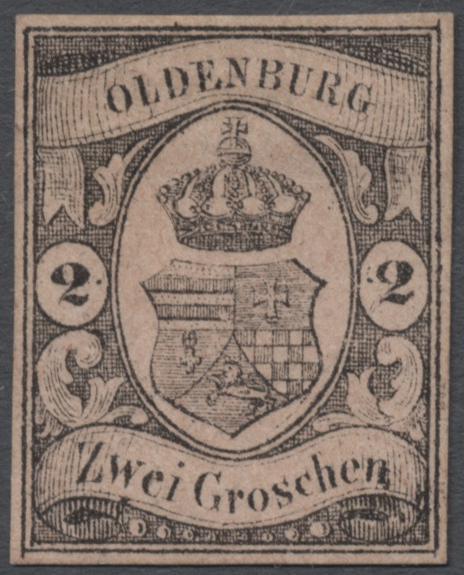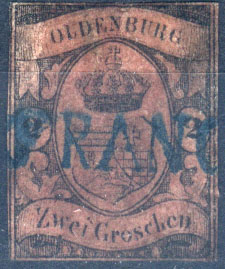








Return To Catalogue - Forgeries of the 1858 issue - Forgeries of the 1860 issue - Oldenburg 1851 issue - miscellaneous - Other German States - Germany
Note: on my website many of the
pictures can not be seen! They are of course present in the cd's;
contact me if you want to purchase them: evert@klaseboer.com.
One of the German States. A Grand Duchy in the north of Germany. It issued stamps from 1852 to 1867, it used the stamps of the North German Confederation afterwards.
Click here for the stamps of the Oldenburg 1852 issue.
1/3 Gr black on green 1 Gr black on blue 2 Gr black on red 3 Gr black on yellow
These stamps became necessary since the currency changed in
1857 (1 Thaler = 30 groschen). They were designed by Gerhard
Stalling and were printed in sheets of 100 (10 rows of 10).
Forgeries exist. For more information click
here.
Value of the stamps |
|||
vc = very common c = common * = not so common ** = uncommon |
*** = very uncommon R = rare RR = very rare RRR = extremely rare |
||
| Value | Unused | Used | Remarks |
| 1/3 g | RRR | RRR | |
| 1 g | RR | *** | |
| 2 g | RRR | RRR | |
| 3 g | RRR | RRR | |
1/3 Gr green 1 Gr blue 2 Gr red 3 Gr yellow
Forgeries exist. For more information click here.
Value of the stamps |
|||
vc = very common c = common * = not so common ** = uncommon |
*** = very uncommon R = rare RR = very rare RRR = extremely rare |
||
| Value | Unused | Used | Remarks |
| 1/3 g | RRR | RRR | |
| 1 g | RR | RR | |
| 2 g | RRR | RRR | |
| 3 g | RRR | RRR | |
1/4 g orange 1/2 g brown
The 1/4 g is cheaper in unused condition (worth about ten times less unused); therefore many forged cancels exist!
Forgeries exist. For more information click here.
Value of the stamps |
|||
vc = very common c = common * = not so common ** = uncommon |
*** = very uncommon R = rare RR = very rare RRR = extremely rare |
||
| Value | Unused | Used | Remarks |
| 1/4 g | RRR | RRR | Used for fractional rates on letters abroad. |
| 1/2 g | RRR | RRR | For local letters. Later it replaced the 1/4 g for fractional rates. |
The remainders of the 1/4 g (about 35,000 stamps) were sold to various stamp dealers and a quantity of 4790 stamps was finally burnt (source: 'The Stamps of the German States' by B.W.H.Poole).
1/3 Gr green 1/2 Gr orange 1 Gr red 2 Gr blue 3 Gr brown
Specialists distinghuish two different kinds of rouletted stamps for this issue (broad and narrow). To facilitate the postal operations throughout the whole of Germany, these stamps have the same colors as the stamps for other German states used during this period. Also, it was now required to fix the stamps in the upper right hand corner of the envelope, instead of the left. These stamps were printed by Mr. Schilling of the Prussian State Printing Works in Berlin. The 1 Gr, 2 Gr and 3 Gr were issued in colors corrresponding to the German-Austrian Postal Union convention.
Value of the stamps |
|||
vc = very common c = common * = not so common ** = uncommon |
*** = very uncommon R = rare RR = very rare RRR = extremely rare |
||
| Value | Unused | Used | Remarks |
| 1/3 g | *** | RR | 490,000 stamps printed |
| 1/2 g | *** | RR | 240,000 stamps printed |
| 1 g | ** | *** | 2,100,000 stamps printed Exists bisected (unauthorized) |
| 2 g | ** | RR | 380,000 stamps printed |
| 3 g | *** | RR | 380,000 stamps printed |
Typical cancels:
Uncancelled stamps (remainders) are cheaper than
cancelled stamps. according to 'The Stamps of the German States'
by B.W.H.Poole, the following quantities of remainders were sold
to Carl Dinklage of Oldenburg who in turn sold most of them to
Mr. Berrig of Hannover:
1/3 gr: 46,000 stamps
1/2 gr: 45,000 stamps
1 gr: 59,000 stamps
2 gr: 63,000 stamps
3 gr: 36,000 stamps
Forged cancels are known to exist for this issue (on remainders)!